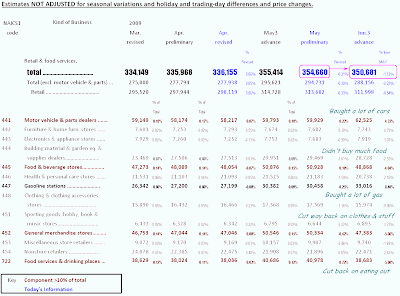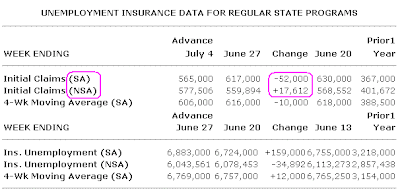



The highest insured unemployment rates in the week ending July 11 were in Puerto Rico (7.3 percent), Michigan (7.2), Oregon (6.7), Pennsylvania (6.4), Nevada (6.2), Wisconsin (6.1), Connecticut (5.6), New Jersey (5.6), Arkansas (5.5), California (5.5), North Carolina (5.5), and South Carolina (5.5).
The largest increases in initial claims for the week ending July 18 were in California (+4,290), Michigan (+3,654), Florida (+3,291), Connecticut (+749), and Indiana (+526),
while the largest decreases were in New York (-22,052), Wisconsin (-6,791), Missouri (-6,529), Pennsylvania (-6,420), and Ohio (-5,062).
 Link to PDF
Link to PDF[Seasonally adjusted] New orders for manufactured durable goods in June decreased $4.1 billion or 2.5 percent to $158.6 billion, the U.S. Census Bureau announced today. This decrease followed two consecutive monthly increases including a 1.3 percent May increase. Excluding transportation, new orders increased 1.1 percent. Excluding defense, new orders decreased 0.7 percent.
[Seasonally adjusted] Shipments of manufactured durable goods in June, down eleven consecutive months, decreased $0.3 billion or 0.2 percent to $168.3 billion. This was the longest streak of consecutive monthly decreases since the series was first published on a NAICS basis in 1992 and followed a 2.6 percent May decrease.
Unfilled orders for manufactured durable goods in June, down nine consecutive months, decreased $6.6 billion or 0.9 percent to $740.1 billion. This followed a 0.3 percent May decrease.
Inventories
Inventories of manufactured durable goods in June, down six consecutive months, decreased $3.0 billion or 0.9 percent to $318.8 billion. This followed a 1.1 percent May decrease.
Capital Goods Industries
Nondefense
Nondefense new orders for capital goods in June decreased $1.8 billion or 3.4 percent to $51.3 billion.
Defense
Defense new orders for capital goods in June decreased $3.4 billion or 28.3 percent to $8.6 billion.



The highest insured unemployment rates in the week ending July 4 were in
Puerto Rico (6.9 percent),
Michigan (6.8),
Oregon (6.8),
Pennsylvania (6.4),
Nevada (6.2),
Wisconsin (6.1),
South Carolina (5.7),
New Jersey (5.6),
North Carolina (5.5), and
Connecticut (5.4).
The largest increases in initial claims for the week ending July 11 were in
New York (+12,504),
North Carolina (+10,382),
Florida (+10,043),
Missouri (+8,293), and
Tennessee (+6,943),
while the largest decreases were in
Michigan (-6,648),
Massachusetts (-2,910),
New Jersey (-2,888),
Indiana (-2,497), and
California (-1,755).

 * * * EPS over rides fundies * * *
* * * EPS over rides fundies * * *
UNEMPLOYMENT INSURANCE WEEKLY CLAIMS REPORT
SEASONALLY ADJUSTED DATA
In the week ending July 11, the advance figure for seasonally adjusted initial claims was 522,000, a decrease of 47,000 from the previous week's revised figure of 569,000. The 4-week moving average was 584,500, a decrease of 22,500 from the previous week's revised average of 607,000.
The advance seasonally adjusted insured unemployment rate was 4.7 percent for the week ending July 4, a decrease of 0.5 percentage point from the prior week's revised rate of 5.2 percent.
The advance number for seasonally adjusted insured unemployment during the week ending July 4 was 6,273,000, a decrease of 642,000 from the preceding week's revised level of 6,915,000. The 4-week moving average was 6,666,750, a decrease of 110,250 from the preceding week's revised average of 6,777,000.
The fiscal year-to-date average for seasonally adjusted insured unemployment for all programs is 5.449 million.
UNADJUSTED DATA
The advance number of actual initial claims under state programs, unadjusted, totaled 667,534 in the week ending July 11, an increase of 86,389 from the previous week. There were 483,981 initial claims in the comparable week in 2008.
The advance unadjusted insured unemployment rate was 4.6 percent during the week ending July 4, an increase of 0.1 percentage point from the prior week. The advance unadjusted number for persons claiming UI benefits in state programs totaled 6,135,066, an increase of 63,714 from the preceding week. A year earlier, the rate was 2.3 percent and the volume was 3,118,724. Release Schedule (available at 9:15 a.m.)
Release Schedule (available at 9:15 a.m.)








 A: I tried to C&P this data as a table, but it didn't work.
A: I tried to C&P this data as a table, but it didn't work.


